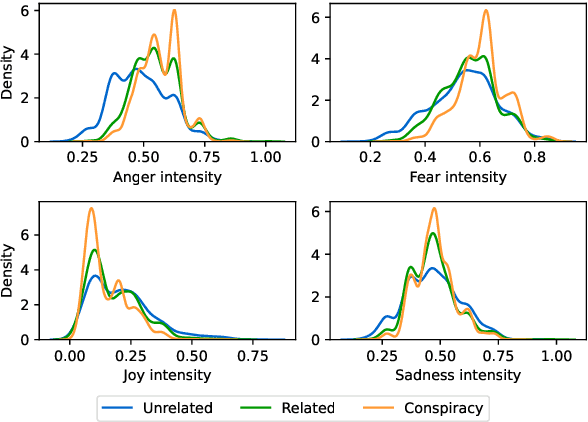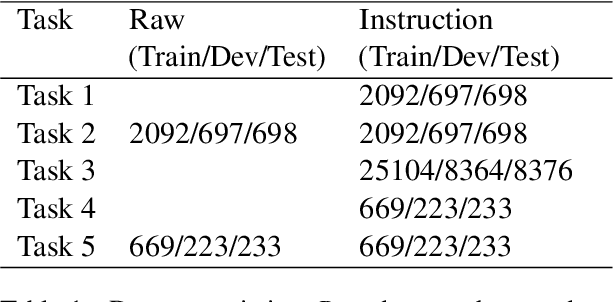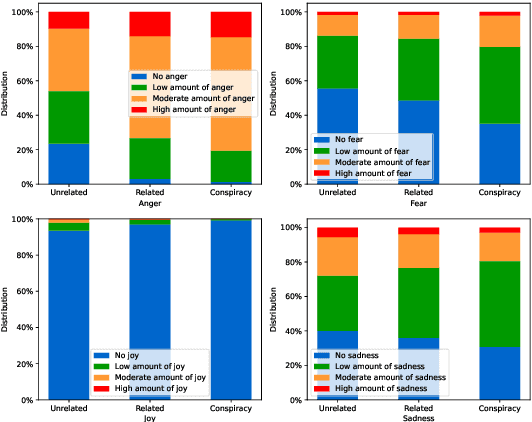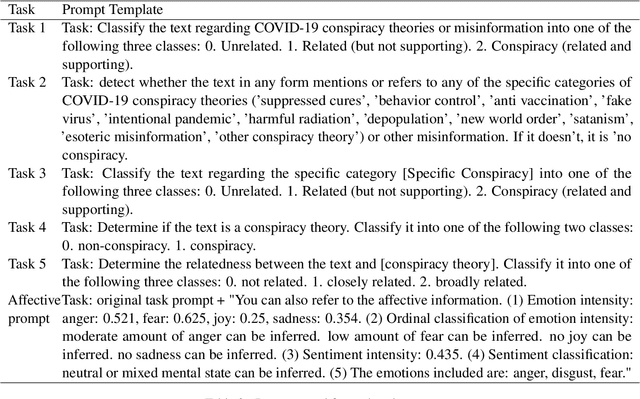Kailai Yang
Rumor Detection by Multi-task Suffix Learning based on Time-series Dual Sentiments
Feb 20, 2025Abstract:The widespread dissemination of rumors on social media has a significant impact on people's lives, potentially leading to public panic and fear. Rumors often evoke specific sentiments, resonating with readers and prompting sharing. To effectively detect and track rumors, it is essential to observe the fine-grained sentiments of both source and response message pairs as the rumor evolves over time. However, current rumor detection methods fail to account for this aspect. In this paper, we propose MSuf, the first multi-task suffix learning framework for rumor detection and tracking using time series dual (coupled) sentiments. MSuf includes three modules: (1) an LLM to extract sentiment intensity features and sort them chronologically; (2) a module that fuses the sorted sentiment features with their source text word embeddings to obtain an aligned embedding; (3) two hard prompts are combined with the aligned vector to perform rumor detection and sentiment analysis using one frozen LLM. MSuf effectively enhances the performance of LLMs for rumor detection with only minimal parameter fine-tuning. Evaluating MSuf on four rumor detection benchmarks, we find significant improvements compared to other emotion-based methods.
Sigma: Differential Rescaling of Query, Key and Value for Efficient Language Models
Jan 23, 2025



Abstract:We introduce Sigma, an efficient large language model specialized for the system domain, empowered by a novel architecture including DiffQKV attention, and pre-trained on our meticulously collected system domain data. DiffQKV attention significantly enhances the inference efficiency of Sigma by optimizing the Query (Q), Key (K), and Value (V) components in the attention mechanism differentially, based on their varying impacts on the model performance and efficiency indicators. Specifically, we (1) conduct extensive experiments that demonstrate the model's varying sensitivity to the compression of K and V components, leading to the development of differentially compressed KV, and (2) propose augmented Q to expand the Q head dimension, which enhances the model's representation capacity with minimal impacts on the inference speed. Rigorous theoretical and empirical analyses reveal that DiffQKV attention significantly enhances efficiency, achieving up to a 33.36% improvement in inference speed over the conventional grouped-query attention (GQA) in long-context scenarios. We pre-train Sigma on 6T tokens from various sources, including 19.5B system domain data that we carefully collect and 1T tokens of synthesized and rewritten data. In general domains, Sigma achieves comparable performance to other state-of-arts models. In the system domain, we introduce the first comprehensive benchmark AIMicius, where Sigma demonstrates remarkable performance across all tasks, significantly outperforming GPT-4 with an absolute improvement up to 52.5%.
FMDLlama: Financial Misinformation Detection based on Large Language Models
Sep 24, 2024Abstract:The emergence of social media has made the spread of misinformation easier. In the financial domain, the accuracy of information is crucial for various aspects of financial market, which has made financial misinformation detection (FMD) an urgent problem that needs to be addressed. Large language models (LLMs) have demonstrated outstanding performance in various fields. However, current studies mostly rely on traditional methods and have not explored the application of LLMs in the field of FMD. The main reason is the lack of FMD instruction tuning datasets and evaluation benchmarks. In this paper, we propose FMDLlama, the first open-sourced instruction-following LLMs for FMD task based on fine-tuning Llama3.1 with instruction data, the first multi-task FMD instruction dataset (FMDID) to support LLM instruction tuning, and a comprehensive FMD evaluation benchmark (FMD-B) with classification and explanation generation tasks to test the FMD ability of LLMs. We compare our models with a variety of LLMs on FMD-B, where our model outperforms all other open-sourced LLMs as well as ChatGPT.
Selective Preference Optimization via Token-Level Reward Function Estimation
Aug 24, 2024



Abstract:Recent advancements in large language model alignment leverage token-level supervisions to perform fine-grained preference optimization. However, existing token-level alignment methods either optimize on all available tokens, which can be noisy and inefficient, or perform selective training with complex and expensive key token selection strategies. In this work, we propose Selective Preference Optimization (SePO), a novel selective alignment strategy that centers on efficient key token selection. SePO proposes the first token selection method based on Direct Preference Optimization (DPO), which trains an oracle model to estimate a token-level reward function on the target data. This method applies to any existing alignment datasets with response-level annotations and enables cost-efficient token selection with small-scale oracle models and training data. The estimated reward function is then utilized to score all tokens within the target dataset, where only the key tokens are selected to supervise the target policy model with a reference model-free contrastive objective function. Extensive experiments on three public evaluation benchmarks show that SePO significantly outperforms competitive baseline methods by only optimizing 30% key tokens on the target dataset. SePO applications on weak-to-strong generalization show that weak oracle models effectively supervise strong policy models with up to 16.8x more parameters. SePO also effectively selects key tokens from out-of-distribution data to enhance strong policy models and alleviate the over-optimization problem.
RAEmoLLM: Retrieval Augmented LLMs for Cross-Domain Misinformation Detection Using In-Context Learning based on Emotional Information
Jun 16, 2024Abstract:Misinformation is prevalent in various fields such as education, politics, health, etc., causing significant harm to society. However, current methods for cross-domain misinformation detection rely on time and resources consuming fine-tuning and complex model structures. With the outstanding performance of LLMs, many studies have employed them for misinformation detection. Unfortunately, they focus on in-domain tasks and do not incorporate significant sentiment and emotion features (which we jointly call affect). In this paper, we propose RAEmoLLM, the first retrieval augmented (RAG) LLMs framework to address cross-domain misinformation detection using in-context learning based on affective information. It accomplishes this by applying an emotion-aware LLM to construct a retrieval database of affective embeddings. This database is used by our retrieval module to obtain source-domain samples, which are subsequently used for the inference module's in-context few-shot learning to detect target domain misinformation. We evaluate our framework on three misinformation benchmarks. Results show that RAEmoLLM achieves significant improvements compared to the zero-shot method on three datasets, with the highest increases of 20.69%, 23.94%, and 39.11% respectively. This work will be released on https://github.com/lzw108/RAEmoLLM.
MetaAligner: Conditional Weak-to-Strong Correction for Generalizable Multi-Objective Alignment of Language Models
Mar 25, 2024Abstract:Recent advancements in large language models (LLMs) aim to tackle heterogeneous human expectations and values via multi-objective preference alignment. However, existing methods are parameter-adherent to the policy model, leading to two key limitations: (1) the high-cost repetition of their alignment algorithms for each new target model; (2) they cannot expand to unseen objectives due to their static alignment objectives. In this work, we propose Meta-Objective Aligner (MetaAligner), a model that performs conditional weak-to-strong correction for weak responses to approach strong responses. MetaAligner is the first policy-agnostic and generalizable method for multi-objective preference alignment, which enables plug-and-play alignment by decoupling parameter updates from the policy models and facilitates zero-shot preference alignment for unseen objectives via in-context learning. Experimental results show that MetaAligner achieves significant and balanced improvements in multi-objective alignments on 11 policy models with up to 63x more parameters, and outperforms previous alignment methods with down to 22.27x less computational resources. The model also accurately aligns with unseen objectives, marking the first step towards generalizable multi-objective preference alignment.
ConspEmoLLM: Conspiracy Theory Detection Using an Emotion-Based Large Language Model
Mar 11, 2024



Abstract:The internet has brought both benefits and harms to society. A prime example of the latter is misinformation, including conspiracy theories, which flood the web. Recent advances in natural language processing, particularly the emergence of large language models (LLMs), have improved the prospects of accurate misinformation detection. However, most LLM-based approaches to conspiracy theory detection focus only on binary classification and fail to account for the important relationship between misinformation and affective features (i.e., sentiment and emotions). Driven by a comprehensive analysis of conspiracy text that reveals its distinctive affective features, we propose ConspEmoLLM, the first open-source LLM that integrates affective information and is able to perform diverse tasks relating to conspiracy theories. These tasks include not only conspiracy theory detection, but also classification of theory type and detection of related discussion (e.g., opinions towards theories). ConspEmoLLM is fine-tuned based on an emotion-oriented LLM using our novel ConDID dataset, which includes five tasks to support LLM instruction tuning and evaluation. We demonstrate that when applied to these tasks, ConspEmoLLM largely outperforms several open-source general domain LLMs and ChatGPT, as well as an LLM that has been fine-tuned using ConDID, but which does not use affective features. This project will be released on https://github.com/lzw108/ConspEmoLLM/.
HealMe: Harnessing Cognitive Reframing in Large Language Models for Psychotherapy
Feb 26, 2024



Abstract:Large Language Models (LLMs) can play a vital role in psychotherapy by adeptly handling the crucial task of cognitive reframing and overcoming challenges such as shame, distrust, therapist skill variability, and resource scarcity. Previous LLMs in cognitive reframing mainly converted negative emotions to positive ones, but these approaches have limited efficacy, often not promoting clients' self-discovery of alternative perspectives. In this paper, we unveil the Helping and Empowering through Adaptive Language in Mental Enhancement (HealMe) model. This novel cognitive reframing therapy method effectively addresses deep-rooted negative thoughts and fosters rational, balanced perspectives. Diverging from traditional LLM methods, HealMe employs empathetic dialogue based on psychotherapeutic frameworks. It systematically guides clients through distinguishing circumstances from feelings, brainstorming alternative viewpoints, and developing empathetic, actionable suggestions. Moreover, we adopt the first comprehensive and expertly crafted psychological evaluation metrics, specifically designed to rigorously assess the performance of cognitive reframing, in both AI-simulated dialogues and real-world therapeutic conversations. Experimental results show that our model outperforms others in terms of empathy, guidance, and logical coherence, demonstrating its effectiveness and potential positive impact on psychotherapy.
The FinBen: An Holistic Financial Benchmark for Large Language Models
Feb 20, 2024Abstract:LLMs have transformed NLP and shown promise in various fields, yet their potential in finance is underexplored due to a lack of thorough evaluations and the complexity of financial tasks. This along with the rapid development of LLMs, highlights the urgent need for a systematic financial evaluation benchmark for LLMs. In this paper, we introduce FinBen, the first comprehensive open-sourced evaluation benchmark, specifically designed to thoroughly assess the capabilities of LLMs in the financial domain. FinBen encompasses 35 datasets across 23 financial tasks, organized into three spectrums of difficulty inspired by the Cattell-Horn-Carroll theory, to evaluate LLMs' cognitive abilities in inductive reasoning, associative memory, quantitative reasoning, crystallized intelligence, and more. Our evaluation of 15 representative LLMs, including GPT-4, ChatGPT, and the latest Gemini, reveals insights into their strengths and limitations within the financial domain. The findings indicate that GPT-4 leads in quantification, extraction, numerical reasoning, and stock trading, while Gemini shines in generation and forecasting; however, both struggle with complex extraction and forecasting, showing a clear need for targeted enhancements. Instruction tuning boosts simple task performance but falls short in improving complex reasoning and forecasting abilities. FinBen seeks to continuously evaluate LLMs in finance, fostering AI development with regular updates of tasks and models.
EmoLLMs: A Series of Emotional Large Language Models and Annotation Tools for Comprehensive Affective Analysis
Jan 16, 2024Abstract:Sentiment analysis and emotion detection are important research topics in natural language processing (NLP) and benefit many downstream tasks. With the widespread application of LLMs, researchers have started exploring the application of LLMs based on instruction-tuning in the field of sentiment analysis. However, these models only focus on single aspects of affective classification tasks (e.g. sentimental polarity or categorical emotions), and overlook the regression tasks (e.g. sentiment strength or emotion intensity), which leads to poor performance in downstream tasks. The main reason is the lack of comprehensive affective instruction tuning datasets and evaluation benchmarks, which cover various affective classification and regression tasks. Moreover, although emotional information is useful for downstream tasks, existing downstream datasets lack high-quality and comprehensive affective annotations. In this paper, we propose EmoLLMs, the first series of open-sourced instruction-following LLMs for comprehensive affective analysis based on fine-tuning various LLMs with instruction data, the first multi-task affective analysis instruction dataset (AAID) with 234K data samples based on various classification and regression tasks to support LLM instruction tuning, and a comprehensive affective evaluation benchmark (AEB) with 14 tasks from various sources and domains to test the generalization ability of LLMs. We propose a series of EmoLLMs by fine-tuning LLMs with AAID to solve various affective instruction tasks. We compare our model with a variety of LLMs on AEB, where our models outperform all other open-sourced LLMs, and surpass ChatGPT and GPT-4 in most tasks, which shows that the series of EmoLLMs achieve the ChatGPT-level and GPT-4-level generalization capabilities on affective analysis tasks, and demonstrates our models can be used as affective annotation tools.
 Add to Chrome
Add to Chrome Add to Firefox
Add to Firefox Add to Edge
Add to Edge